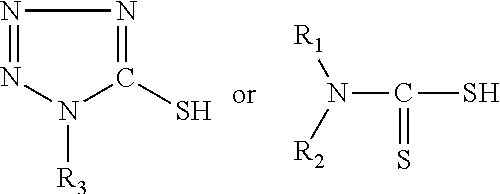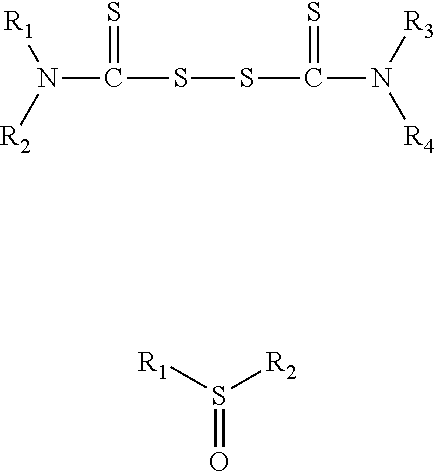[0013]While not wishing to be bound to any particular theory, it is now believed that presbyopia is caused by the hardening of the lens, which can be due to an alteration of the structural proteins or an increased adhesion between the lens fibers. It is also believed that the intralenticular viscosity increases with age as a result of the formation of certain chemical bond structures within the lens. Accordingly, the present invention is directed to method and apparatus for preventing and or reversing presbyopia through treatment of the lens such that the viscosity of the lens is reduced, restoring the elasticity and movement to the lens fibers and increasing the accommodative amplitude of the lens.
[0015]In an embodiment, the present invention provides a novel molecular approach to reversing presbyopia by restoring the accommodative amplitude of the lens, and in another preferred embodiment, to reversing presbyopia while also reducing the tendency for the lens to lose its thus restored accommodative amplitude.
[0016]In another embodiment of the invention the onset of presbyopia is prevented by regularly administered treatment where elasticity and the accommodative ability of the lens is restored. By applying the treatments as described herein to the eyes of persons in their mid to late 30's, or even younger, the on-set of presbyopia, as defined by a loss of accommodation, such that the accommodative power of the eye is below 2.5 Diopters, can be avoided. In one embodiment of the invention, such treatments whether for the purposes of preventing or reversing presbyopia, would be occasionally repeated during the course of a patient's lifetime. The frequency of the treatment would be determined by the degree of accommodative loss that needs to be recovered, the amount of accommodation that can be safely restored in a single procedure, and the amount of restoration desired.
[0017]In one embodiment, the present invention is directed to a method for reversing and / or treating presbyopia by breaking disulfide bonds in molecules comprising the structures of the eye, most notably the lens and the lens capsule, in which disulfide bonds are believed to be a substantial factor in the progressive loss of accommodative amplitude. In another embodiment, the breaking of the disulfide bonds is accompanied by chemical modification of the sulfur moiety in the cysteine molecule formed upon breaking of the disulfide bonds, such chemical modification rendering the sulfur moiety less likely to form new disulfide bonds. This method thus comprises a method for preventing, and / or reducing the recurrence of presbyopia by reducing the probability of forming new disulfide bonds. Particularly, this invention affects a change in the accommodative amplitude of the human lens by: (1) using various reducing agents that cause a change in the accommodative abilities of the human lens, and / or (2) the use of applied energy to affect a change in the accommodative abilities of the human lens. It is believed that by breaking bonds, such as disulfides, that crosslink lens fibers together and increase lens viscosity causing a hardening of the lens cortex and lens nucleus, the present invention increases the elasticity and the distensibility of the lens cortex, lens nucleus, and / or the lens capsule.
[0018]Presbyopia, or the loss of the accommodative amplitude of the lens, has often advanced in a typical person age 45 or older to the point where some type of corrective lens in the form of reading glasses or other treatment is required. It is to be understood that loss of accommodative amplitude can occur in persons much younger or older than the age of 45, thus the present invention is not to be construed as limited to the treatment of presbyopia in a person of any particular age. The present invention is most useful in a person whose accommodative amplitude has lessened to a point where restoration thereof to some degree is desirable. However the invention should not be limited to the correction of presbyopia, but may be used to prevent presbyopia from occurring.
[0019]In one embodiment of the present invention, the method of reversing or preventing presbyopia will result in an increase in the accommodative amplitude at least about by 0.5 diopters. In another embodiment of the present invention, the method of reversing or preventing presbyopia will result in an increase in the accommodative amplitude of at least about 2.0 diopters. In still another embodiment, the method of reversing or preventing presbyopia of the present invention will result in an increase in the accommodative amplitude by at least about 5 diopters. In another embodiment of the present invention, the method of reversing or preventing presbyopia of the present invention will result in an increase of the accommodative amplitude of the lens to restoration thereof to that of a lens with a normal accommodative amplitude of 2.5 diopters or greater. It is noted that while it is obviously most beneficial to restore the accommodative amplitude of the lens to a normal accommodative amplitude, lesser degrees of restoration are also beneficial. For example, in some cases advanced presbyopia can cause severe reduction in the accommodative amplitude, thus making a complete restoration of the amplitude improbable.
 Login to View More
Login to View More  Login to View More
Login to View More 

